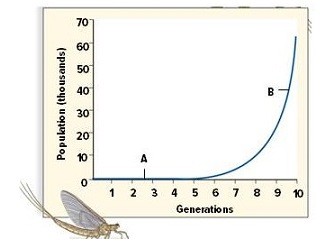Tell what type of growth model is depicted in the graph and describe the factors that must be met for a population to experience this type of growth. Identify the labeled phases, "A" and "B," and briefly explain what occurs during these phases.
What will be an ideal response?
Answers may vary. This is an exponential growth curve. For exponential growth to occur, abundant food, shelter, room, and any other requirements necessary to sustain growth must be available. With exponential growth, the number of individuals added each generation increases as the total number of females increases. "A" is the lag phase. During this phase, growth is slow because the population is small. "B" is the exponential growth phase, during which growth is accelerating.
You might also like to view...
The most common cause of epidemic waterborne diarrheal disease is ________.
A. Naegleria B. Acanthamoeba C. Giardia intestinalis D. All of the choices are correct.
Which of the following characteristics do ostracoderms and lampreys share?
A. Both are extinct. B. Both have fins. C. Both are parasitic on other fish. D. Both are jawless. E. All the choices provided are correct.
A cell that accumulates lots of mutational damage to its DNA may escape the normal controls of the cell cycle and
become ____________________. Fill in the blank(s) with the appropriate word(s).
How is the chromosome of a bacterial cell replicated?
a. The linear DNA molecule is replicated from multiple origins of replication bidirectionally. b. The linear DNA molecule is replicated from one origin of replication bidirectionally. c. The circular DNA molecule is replicated from multiple origins of replication bidirectionally. d. The circular DNA molecule is replicated from one origin of replication bidirectionally. e. The circular DNA molecule is replicated from one origin of replication unidirectionally.